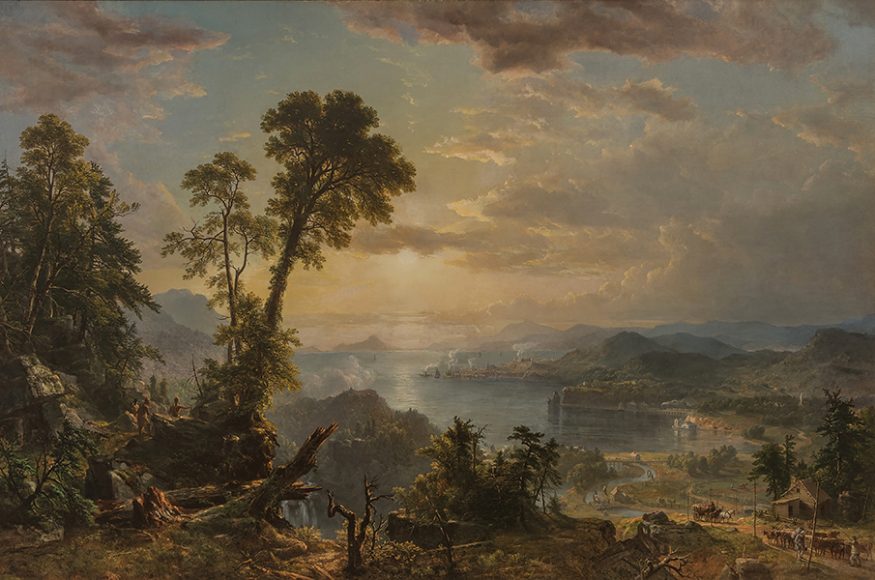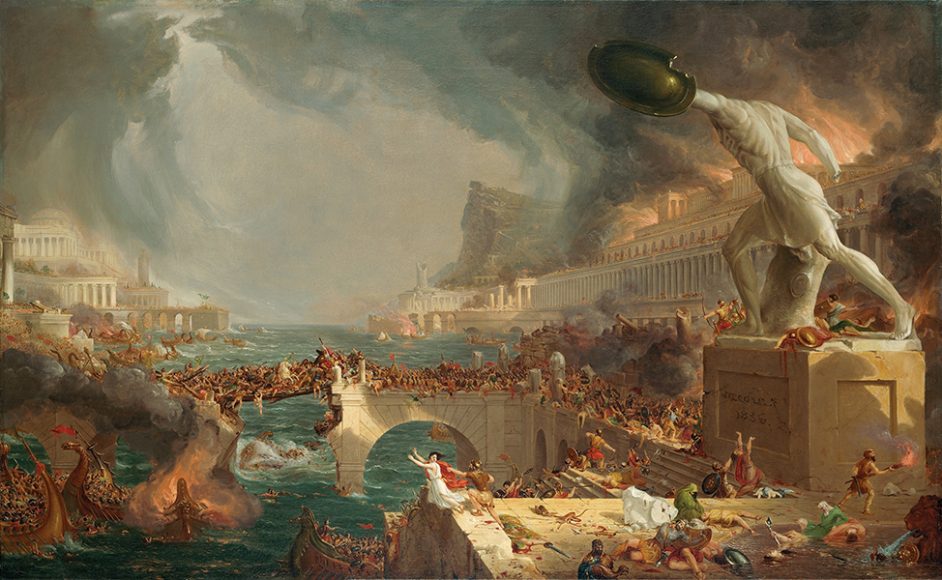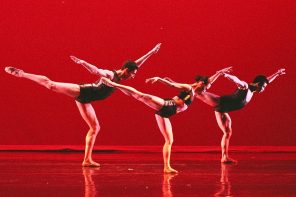With four late-winter nor’easters virtually back to back (to back to back), many in WAG country have concluded what others have long suspected:
Mother Nature is a, well, rhymes with witch.
But is nature really both so wondrous and terrifying? Or is it merely the personification and reflection of the civilization we have created?
These are questions that have haunted artists for centuries but perhaps none more so than the Hudson River School painters, who defined America as the new Eden in the decades that bracketed the Civil War. They in turn were shaped by a Europe whose vision of America they influenced. This transatlantic symbiosis is the subject of “Thomas Cole: Atlantic Crossings,” on view at The Metropolitan Museum of Art through May 13 before traveling on to The National Gallery in London.
The exhibit helps “establish Cole as a major global figure in 19th-century landscape art, in dialogue with his esteemed European contemporaries, including Joseph Mallord William Turner and John Constable,” write Met President and CEO Daniel H. Weiss and National Gallery Director Gabriele Finaldi. “By exploring the impact of Cole’s journeys to England and to Italy between 1829 and 1832, the exhibition and catalog offer a significant revision of previous accounts of his work, which have, until now, emphasized the American aspects of his formation and identity.”
That identity was bound up with a skeptical view of civilization’s effects on nature. In this, Cole, the Catskill-based founder of the Hudson River School, may have been joined by his student, Asher B. Durand, another first-generation member of the movement. The accompanying exhibit text describes Durand’s “Progress (The Advance of Civilization)” (1853, oil on canvas) as “a hymn to industrialization and technology. Progress appropriates the (Claude Lorrain) formula, with graceful framing trees and a distant waterway, for a spectacular exposition of the doctrine of Manifest Destiny, which claims a unique historical status for the United States. The modern achievements are laid out in chronological order — a road carved out from the virgin forest and a log cabin, a canal with a lock and barges, the symbolic white tower of a Protestant church and a locomotive moving across a bridge. Alongside the river, which resembles the Hudson, is an industrial town. The brilliant, Turnerian burst of sunlight throws a divine blessing over modern enterprise.”
But not so fast. That burst of sunlight shadows the left side of the canvas, in which three Indians watch the parade of civilization from a cliff. Beneath them are shards of tree trunks. Everyone’s sunrise is someone else’s sunset. “Progress” seems as much a comment on what is lost in “the advance of civilization” as on what is gained.
And what is gained can easily be lost again. Cole’s trips to England and Italy inspired his epic series of oils on canvas, “The Course of Empire” (1834-36), which charts the tragic trajectory of a civilization unspooled as much by its own oblivious arrogance as by violence. (Sound familiar?) “The Savage State” offers us cloud-swathed, coastal mountain greenery at dawn, with the Indians as early hunter-gatherers. In “The Arcadian, or Pastoral, State,” much of the land has been cleared, almost voluptuously so, giving way to the highest pleasures of civilization — arts and leisure. An old man fishes. A couple strolls as a child does a chalk drawing on the ground. Others dance as a piper plays. And in the distance, smoke wafts from a Stonehenge-like temple, indicating perhaps the ceremonial fires of worship.
“The Consummation” depicts an empire at high noon that 1950s Hollywood would’ve killed for. Terraces; jets of water; boats with pastel-colored sails; marble buildings that vie with the figure of Minerva, the Roman goddess of wisdom, atop a pavilion, for gleaming white splendor; a parade led by an imperial, red-robed figure; and, everywhere, other signs of life’s coarsest pleasures, vanity and spectacle — this takes the Lorrain playbook — sun-dappled seascapes flanked by neoclassical buildings — and goes it one better. But it gives way to a Turner-esque swirl of dark clouds, rising waves, invasion, rape and pillage in “Destruction.” In the final canvas, “Desolation,” nature reclaims its own. Vines encircle ruins. They and a rising, winking moon are all that is left to remind us of what was and what might’ve been.
And that there is a razor-thin margin between order and chaos, rationality and madness, civilization and unbridled nature. We need not mine the veins of history for the examples of the Polynesians on Easter Island and the Maya in Mexico and Central America, who created rich civilizations and, in responding to a variety of crises, including environmental ones, walked away from them. Indeed, we only have to go as far back as the recent hurricanes in Houston, Florida and the Caribbean to see the fragility of what we’ve created — and abused. The irony: We may return to what we fail to respect, relinquishing civilization in the bargain as nature reclaims its own.
The irony is not lost on Cole’s spiritual successors, including the five artists who make up “The Tipping Point,” a contemporary show on climate change at the Rockland Center for the Arts in West Nyack through May 25. One of the artists, Alison Moritsugu, echoes him quite literally in landscapes on wood slices that speak of creativity and destruction.
J. Henry Fair’s aerial photographs capture the need for sustainable human consumption, while David Maisel’s photographs consider the effects of open pit mines, sprawl and water reclamation on the land. Glass artist and architect Richard Parrish plumbs where man and nature cooperate — and collide — while Jill Pelto explores the intersection of art and science as a Master of Science student studying the Antarctic Ice Sheet at the University of Maine and creating glaciogenic art.
Almost 200 years separate the works of Cole and those of these artists. The question is, Will we still be pondering the nature-nurture divide in another 200 years?
For more, visit metmuseum.org and rocklandartcenter.org.






